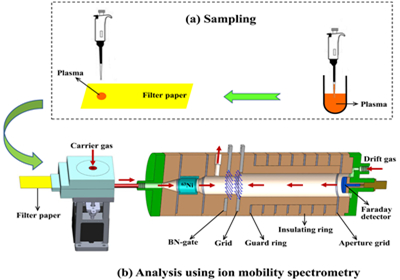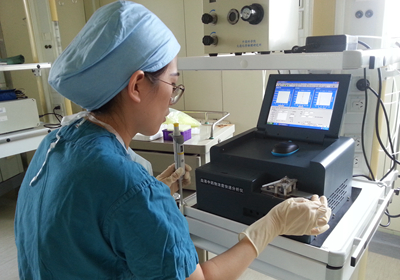Propofol is the most commonly used intravenous anaesthetic in the surgery. The target controlled infusion (TCI) devices are used for controlling propofol concentrations in clinical practice. However, the TCI models are not suitable for the personalized medicine. Otherwise, there is a limitation for propofol, excessive or insufficient dosage would lead to serious syndrome of propofol and even death. Therefore, monitoring the propofol concentrations during the surgery is of great significance to enhance the safety of patients. Due to the complicated sample pretreatment, time consuming analysis and delayed response time, it was hard for the current detection instruments to be used in the clinical practice. Nowadays, there is an urgent need for a kind of instrument which can real-time monitor the depth of anesthesia and control the amount of anesthetic precisely.
Dalian Institute of Chemical Physics research group led by Prof. LI Haiyang has been committed to the new method and technique research. The improvement of resolution and selectivity technology for Ion mobility spectrometry (IMS) promoted its application in clinical practice. Through the cooperation with the First Affiliated Hospital of Harbin Medical University for three years, the rapid analytical detection of the propofol from a drop of blood was realized. In this research, there was no complicated sample pre-treatment with the plasma samples. Each individual measurement could be accomplished within 1 min. Combination medical glass microfiber paper with the gradient thermal desorption technique, the layered thermal desorption of the plasma complex mixtures was realized. These measurement results did meet the clinical application requirements.
Furthermore, other clinically-often-used drugs, including remifentanil, flurbiprofen and atracurium, were found no significant interference with the qualitative and quantitative analysis of the plasma propofol. For the plasma propofol concentrations the linear range was from 1 to 12 μg mL-1, while the limit of detection was evaluated to be 0.1 μg mL-1. This result provided certain scientific basis for the anesthetists to adjust the anesthetic dosage and make rational dosage regimen of anesthesia. At the same time, it could help to explain why low or high depth of anesthesia led to the intraoperative knows or medical accidents. Thus, the empirical anesthesia clinical drug use reached a high scientific level. At present, this method and the plasma concentration detector have been developed to the clinical application of demonstration in the First Affiliated Hospital of Harbin Medical University, and compared with the TCI concentration and bispectral (BIS) index. The theory and technology was expected to lead the technical innovation and there was a broad market application prospect.


Figure DICP researchers develop a new method and instrument for propofol concentration detection from a drop of blood (Imaged by WANG Xin and JIANG Dandan)
In this work, there was no complicated sample pre-treatment process, and layered thermal desorption was realized by a drop of blood dropped directly onto the surface of analyzer. This result has been published on Scientific Reports owned by Nature (DOI: 10.1038/srep37525) (Text and Imaged by WANG Xin and JIANG Dandan)
Dr. LU Xinyi
Dalian Institute of Chemical Physics, Chinese Academy of Sciences,
457 Zhongshan Road, Dalian, 116023, China,
Tel: 86-411-84379201,
E-mail: luxinyi@dicp.ac.cn